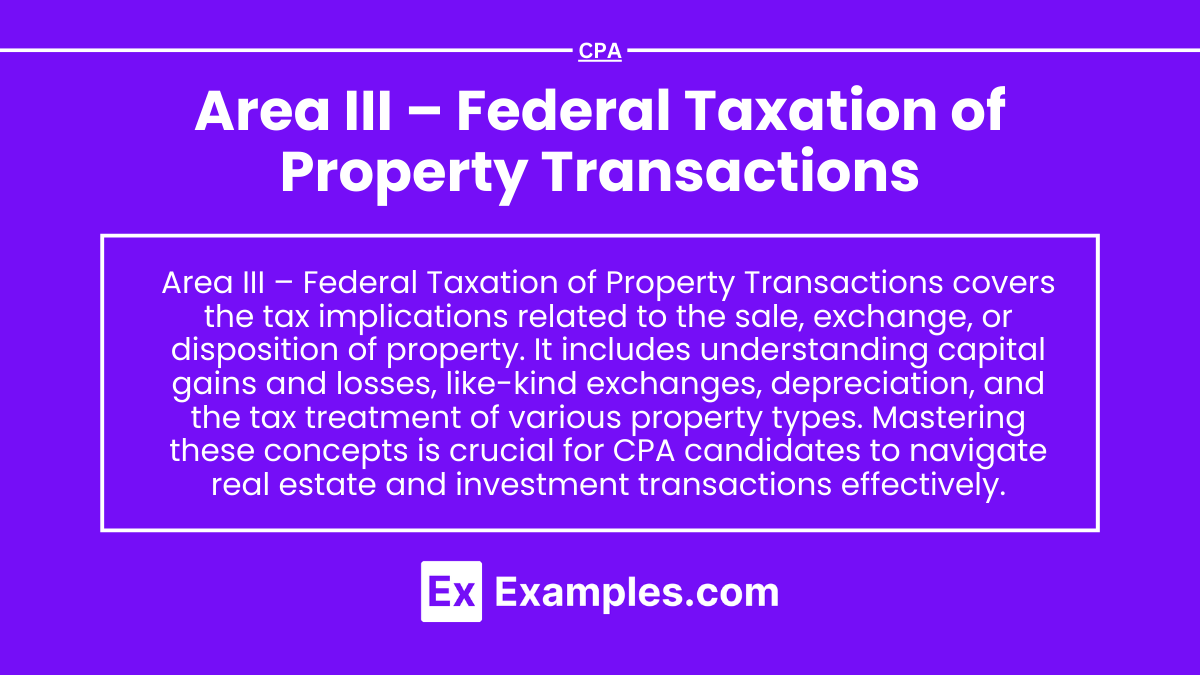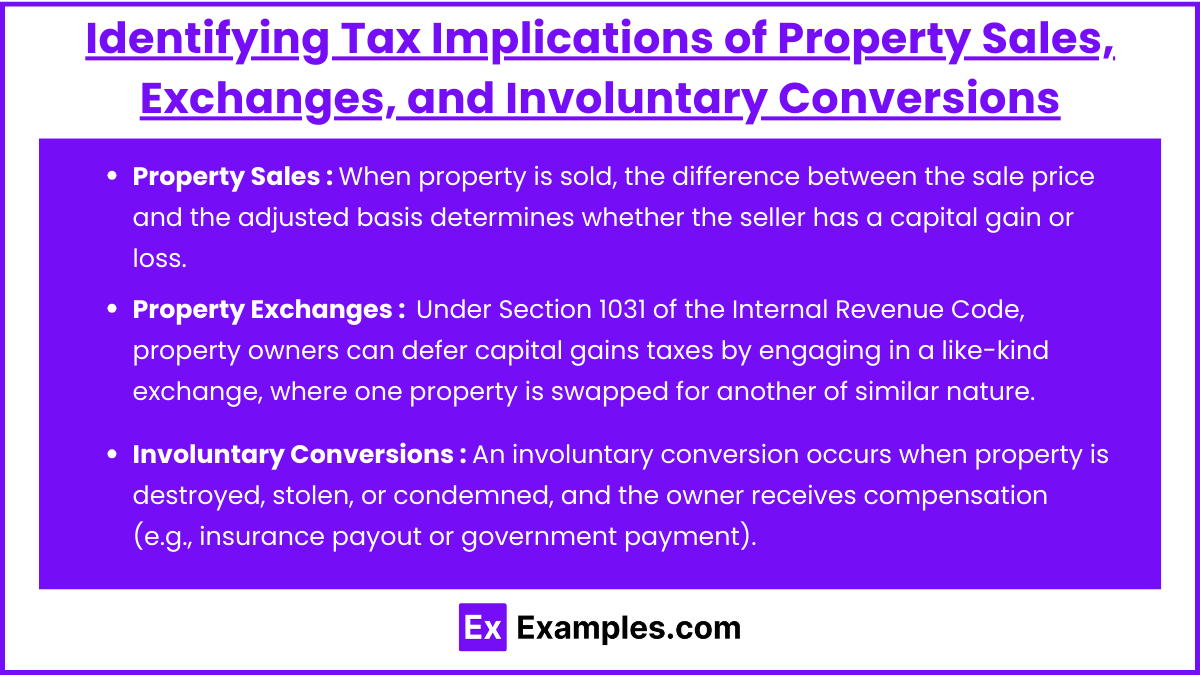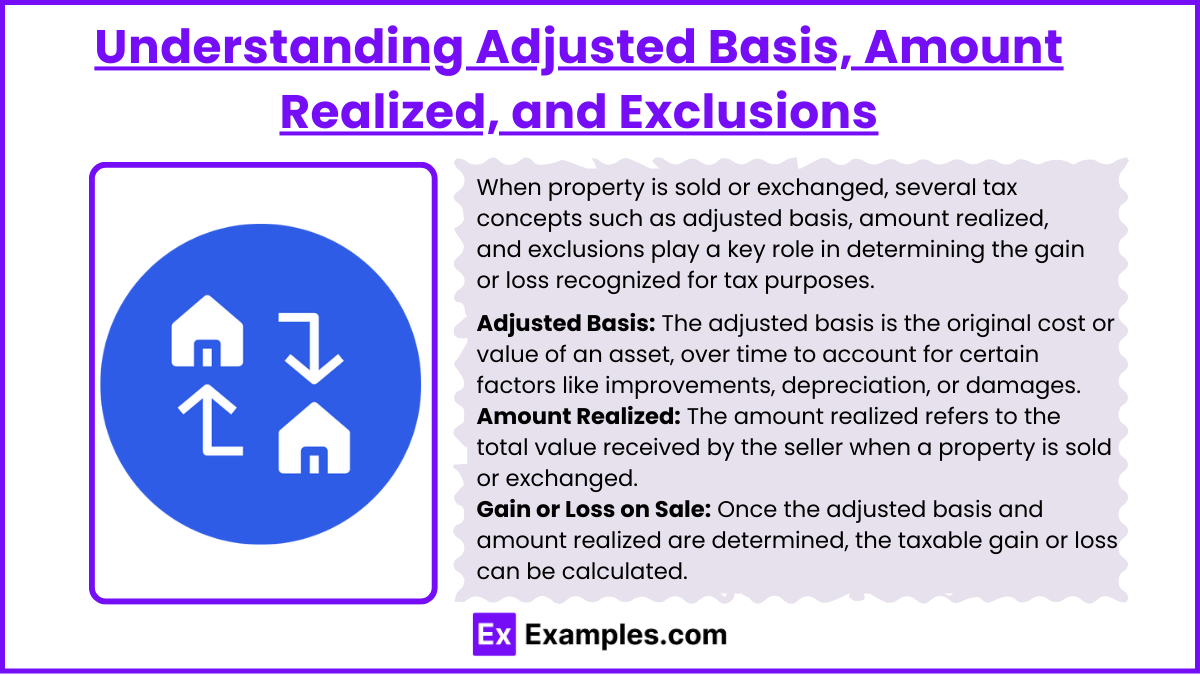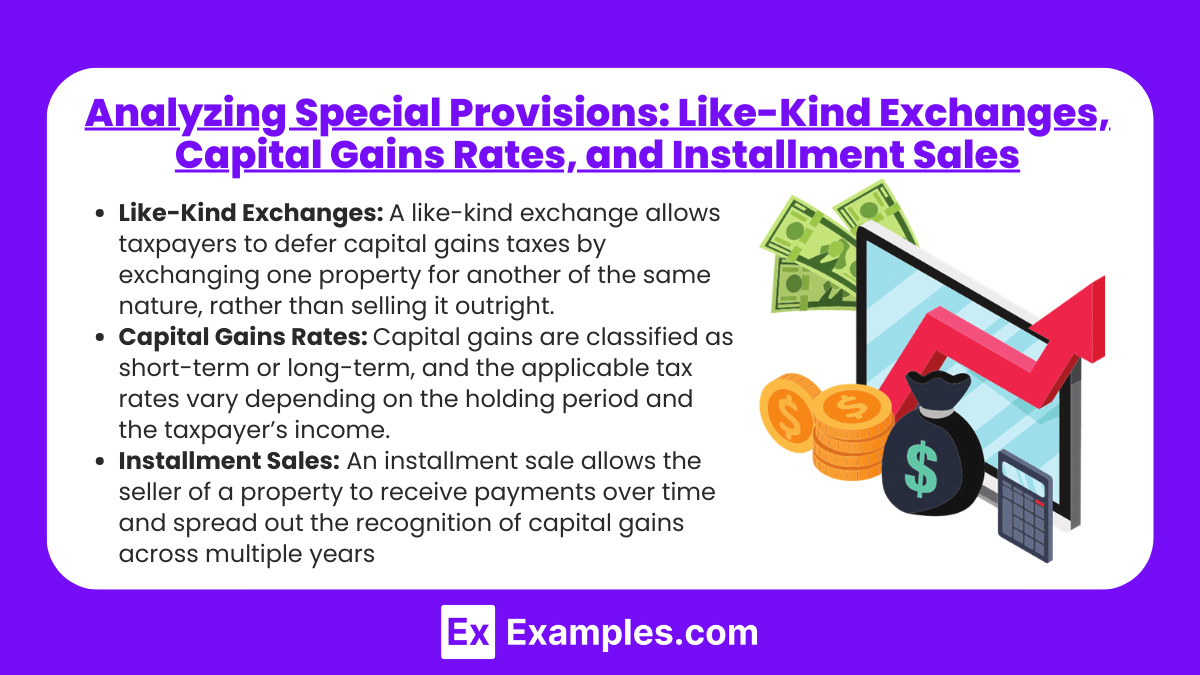On the CPA Exam, Federal Taxation of Property Transactions covers essential topics related to the acquisition, disposition, and exchange of property. You'll explore capital gains and losses, depreciation, and tax implications of like-kind exchanges. This area also focuses on installment sales, involuntary conversions, and passive activity losses. Understanding the rules governing these transactions is crucial for mastering tax planning, compliance, and reporting. These concepts are key to successfully navigating the Regulation (REG) section of the exam and ensuring proficiency in applying tax laws effectively.
Learning Objectives
In studying "Area III – Federal Taxation of Property Transactions" for the CPA Exam, you should learn to identify the tax implications of property sales, exchanges, and involuntary conversions. Understand how to calculate realized and recognized gains or losses, including the effect of adjusted basis, amount realized, and exclusions. Analyze special provisions, such as like-kind exchanges, capital gains tax rates, and installment sales. Evaluate the rules for depreciation recapture and their impact on taxable income. Additionally, develop proficiency in applying federal tax laws to different property types, including personal, business, and investment property, to determine correct tax treatments.
Identifying Tax Implications of Property Sales, Exchanges, and Involuntary Conversions
The sale, exchange, or involuntary conversion of property has significant tax implications. The IRS classifies these transactions as capital events that may result in taxable gains or losses. Proper understanding of the tax rules helps individuals and businesses make informed decisions and take advantage of potential tax deferrals or exclusions.
1. Property Sales
When property is sold, the difference between the sale price and the adjusted basis (original cost plus improvements, minus depreciation) determines whether the seller has a capital gain or loss.
Key Tax Implications of Property Sales
Capital Gains or Losses:
Capital Gain: If the sale price exceeds the adjusted basis, the seller realizes a capital gain.
Capital Loss: If the sale price is lower than the adjusted basis, the seller incurs a capital loss (deductible only for investment or business property, not personal property).
Short-Term vs. Long-Term Gains:
Short-term capital gains (held for one year or less) are taxed at ordinary income tax rates.
Long-term capital gains (held for more than one year) receive favorable tax rates, ranging from 0% to 20% depending on the taxpayer's income.
Principal Residence Exclusion:
Homeowners may exclude up to 500,000 for married couples) of capital gains on the sale of a primary residence, provided they meet ownership and use tests (lived in the home for at least two of the last five years).
Example: A homeowner sells a house for 200,000. The $100,000 gain is excluded if it meets the primary residence exclusion criteria.
2. Property Exchanges (Like-Kind Exchanges)
Under Section 1031 of the Internal Revenue Code, property owners can defer capital gains taxes by engaging in a like-kind exchange, where one property is swapped for another of similar nature.
Tax Implications of Like-Kind Exchanges
Deferral of Capital Gains: No gain or loss is recognized at the time of the exchange. Instead, the tax basis of the old property is transferred to the new property.
Qualifying Property: Only investment or business property qualifies (e.g., real estate for real estate). Personal property no longer qualifies under the Tax Cuts and Jobs Act (TCJA) of 2017.
Time Limits: Replacement property must be identified within 45 days of selling the original property, and the exchange must be completed within 180 days.
Example: A rental property owner exchanges one rental property for another without triggering immediate capital gains tax, deferring the gain until the replacement property is sold.
3. Involuntary Conversions
An involuntary conversion occurs when property is destroyed, stolen, or condemned, and the owner receives compensation (e.g., insurance payout or government payment).
Tax Implications of Involuntary Conversions
Recognition of Gain: If the compensation exceeds the adjusted basis of the property, the owner may realize a capital gain.
Example: An insurance company pays 100,000 adjusted basis, resulting in a $20,000 gain.
Deferral of Gain (Section 1033): Gain can be deferred if the owner reinvests the compensation into similar property within a specified period (usually two years, or three years for condemned real estate).
The new property takes on the adjusted basis of the old property, deferring the tax until the new property is sold.
Losses on Personal Property: Losses on personal-use property (like a home or car) are generally not deductible unless the loss is related to a federally declared disaster.
Example: A business owner receives $500,000 from the government for a condemned warehouse and reinvests it in a new warehouse within the allowed time. The gain is deferred, and no tax is owed until the new warehouse is sold.
Understanding Adjusted Basis, Amount Realized, and Exclusions
When property is sold or exchanged, several tax concepts such as adjusted basis, amount realized, and exclusions play a key role in determining the gain or loss recognized for tax purposes. Properly understanding these concepts helps taxpayers calculate their taxable income accurately and take advantage of any applicable exclusions or deferrals.
1. Adjusted Basis
The adjusted basis is the original cost or value of an asset, adjusted over time to account for certain factors like improvements, depreciation, or damages. It represents the taxpayer’s investment in the property and is used to determine the taxable gain or loss when the property is sold or exchanged.
How to Calculate Adjusted Basis:
Adjusted Basis = Original Cost+Capital Improvements−Depreciation−Casualty Losses.
Original Cost: The price paid for the property, including purchase fees.
Capital Improvements: Expenses that increase the value or extend the life of the property (e.g., a new roof, major renovations).
Depreciation: For business or rental property, depreciation reduces the basis as the property is used over time.
Casualty Losses: Any loss due to theft, fire, or natural disaster (if not compensated by insurance) also reduces the basis.
Example: rental property is purchased for 20,000 in improvements and claims $30,000 in depreciation over several years.Adjusted Basis = 200,000+20,000−30,000 = 190,000.
2. Amount Realized
The amount realized refers to the total value received by the seller when a property is sold or exchanged. It includes not only cash but also other forms of compensation, such as the assumption of liabilities.
Formula for Amount Realized:
Amount Realized = Sale Price+Other Compensation−Selling Expenses
Sale Price: The gross amount agreed upon by the buyer and seller.
Other Compensation: Includes any non-cash payments or the assumption of liabilities by the buyer.
Selling Expenses: Expenses related to the sale (e.g., real estate commissions, legal fees) reduce the amount realized.
Example: A property is sold for 50,000 mortgage. The seller incurs $10,000 in closing costs.Amount Realized = 300,000+50,000−10,000 = 340,000.
3. Gain or Loss on Sale
Once the adjusted basis and amount realized are determined, the taxable gain or loss can be calculated.
Formula for Gain or Loss:
Gain or Loss = Amount Realized−Adjusted Basis
Capital Gain: If the amount realized is greater than the adjusted basis.
Capital Loss: If the amount realized is less than the adjusted basis.
Example: Using the previous examples, the adjusted basis is 340,000.Gain = 340,000−190,000= 150,000.
Analyzing Special Provisions: Like-Kind Exchanges, Capital Gains Rates, and Installment Sales
The tax code offers special provisions that can help taxpayers manage their obligations on property transactions. These include like-kind exchanges, capital gains tax rates, and installment sales. Each provision provides specific benefits, such as tax deferrals or reduced tax rates, helping individuals and businesses optimize their tax liabilities.
1. Like-Kind Exchanges (IRC Section 1031)
A like-kind exchange allows taxpayers to defer capital gains taxes by exchanging one property for another of the same nature, rather than selling it outright. This provision applies to investment or business property, such as real estate.
Key Provisions:
Tax Deferral: No capital gains tax is owed at the time of the exchange; the tax is deferred until the new property is sold.
Qualifying Property: Only real property held for investment or business purposes qualifies (e.g., rental properties). Personal property is no longer eligible under the Tax Cuts and Jobs Act (2017).
Timeline Requirements:
45-day identification period: The replacement property must be identified within 45 days of selling the original property.
180-day completion period: The entire exchange must be completed within 180 days.
Basis Transfer: The adjusted basis of the original property carries over to the replacement property.
Example: A rental property owner exchanges a $500,000 rental property for another of similar value. No capital gains tax is owed until the new property is sold.
2. Capital Gains Rates
Capital gains are classified as short-term or long-term, and the applicable tax rates vary depending on the holding period and the taxpayer’s income.
Key Provisions:
Short-Term vs. Long-Term Capital Gains:
Short-term gains (property held for one year or less) are taxed at ordinary income tax rates.
Long-term gains (property held for more than one year) benefit from lower, preferential tax rates.
Long-Term Capital Gains Rates:
0%: For taxpayers in the 10% or 12% income brackets.
15%: For taxpayers in higher brackets, up to a certain threshold.
20%: For taxpayers in the top income bracket.
Special Rates for Certain Assets:
Collectibles: Gains are taxed at a maximum rate of 28%.
Depreciation Recapture (on real estate): Gains attributable to depreciation are taxed at a maximum of 25%.
Example: A taxpayer sells stock held for two years, realizing a 1,500 in taxes.
3. Installment Sales (IRC Section 453)
An installment sale allows the seller of a property to receive payments over time and spread out the recognition of capital gains across multiple years, rather than reporting the entire gain in the year of the sale.
Key Provisions:
Tax Deferral: Only a portion of the gain is recognized in each year as payments are received, reducing the immediate tax burden.
Calculating the Gain for Each Installment:
The gross profit percentage is calculated as: Gross Profit Percentage = Profit/Sale Price.
This percentage is applied to each payment to determine the taxable portion.
Interest Component: If the sale involves an installment plan, interest income may also need to be reported, which is taxed at ordinary income rates.
Exclusions: Installment sales are not permitted for publicly traded stock or property held primarily for sale (e.g., inventory).
Example: A taxpayer sells land for 60,000 gain, and agrees to receive payments of $20,000 annually over five years. Each payment includes:Gross Profit Percentage = 60,000/100,000 = 60%
For each 12,000 ($20,000 × 60%) is recognized as a capital gain annually.
Applying Federal Tax Laws to Different Property Types
Federal tax laws distinguish between various types of property, including personal property, investment property, business property, and real estate. Each category is subject to specific rules for taxation, depreciation, capital gains, and other tax-related provisions. Understanding how tax laws apply to different property types helps individuals and businesses optimize their tax liabilities.
1. Personal Property
Personal property includes items used for personal purposes, such as vehicles, furniture, or personal-use real estate (e.g., primary residences). Gains or losses on personal property sales are treated differently from business or investment property.
Key Tax Rules for Personal Property:
Capital Gains: Gains on the sale of personal property (like a second home) are subject to capital gains tax.
The principal residence exclusion under IRC Section 121 allows homeowners to exclude up to 500,000 for married couples) of gain on the sale of a primary residence.
No Deductible Losses: Losses from the sale of personal property are not deductible on the taxpayer's return.
Depreciation: Personal-use property cannot be depreciated for tax purposes, even if it loses value over time.
Example: A taxpayer sells a vacation home and realizes a $30,000 gain. This gain is subject to capital gains tax, as it does not qualify for the primary residence exclusion.
2. Investment Property
Investment property is acquired primarily to generate rental income or capital appreciation, such as rental homes, stocks, and bonds. These properties are subject to favorable capital gains rates.
Key Tax Rules for Investment Property:
Capital Gains and Losses:
Gains on the sale of investment property held for more than one year are taxed at long-term capital gains rates (0%, 15%, or 20%).
Losses on investment property can be deducted against capital gains, and up to $3,000 in net capital losses can be used to offset ordinary income.
Rental Income Taxation: Rental income from investment property is taxable, but the owner can deduct operating expenses, property taxes, and mortgage interest.
Depreciation: Investment real estate can be depreciated over 27.5 years for residential properties or 39 years for commercial properties.
Example: A taxpayer sells a rental property for a $50,000 gain. The gain is taxed at long-term capital gains rates if the property was held for more than one year.
3. Business Property
Business property includes assets used directly in a business, such as machinery, equipment, and commercial buildings. These assets qualify for special tax treatment, including depreciation and Section 179 deductions.
Key Tax Rules for Business Property:
Depreciation:
Business property is depreciated over its useful life, using MACRS (Modified Accelerated Cost Recovery System).
Section 179 allows businesses to immediately expense certain property purchases (up to the annual limit) instead of depreciating them.
Capital Gains and Depreciation Recapture:
Gains from the sale of business property are generally treated as capital gains.
However, gains attributed to previous depreciation are taxed as ordinary income through depreciation recapture.
Casualty Losses: Losses from theft, disaster, or other involuntary events can be deducted.
Example: A business purchases equipment for 6,000, the amount exceeding the depreciated value will be taxed as a capital gain.
4. Real Estate Property
Real estate includes residential, commercial, and rental properties, which can fall under personal use, business, or investment categories.
Key Tax Rules for Real Estate:
Depreciation:
Rental property can be depreciated over 27.5 years (residential) or 39 years (commercial).
Depreciation reduces the property’s basis, potentially increasing capital gains when the property is sold.
Like-Kind Exchanges: Under Section 1031, real estate investors can defer capital gains taxes by exchanging one property for another of like-kind.
Principal Residence Exclusion: Homeowners can exclude gains of up to 500,000 for couples) on the sale of their primary residence if they meet ownership and use requirements.
Capital Gains Rates: Long-term capital gains on real estate are taxed at 15% or 20% depending on the taxpayer’s income, with depreciation recapture taxed at a maximum of 25%.
Example: A taxpayer sells a rental property for a gain of $100,000. Since the property was depreciated, part of the gain may be taxed as depreciation recapture at 25%.
Examples
Example 1: Sale of Real Estate
When an individual sells real estate, such as a home or investment property, they may be subject to capital gains tax on the profit made from the sale. If the property has appreciated significantly in value since its purchase, the seller needs to calculate the difference between the sale price and the adjusted basis (original purchase price plus any improvements). Understanding the tax implications helps individuals plan for potential tax liabilities.
Example 2: Like-Kind Exchange of Real Property
A like-kind exchange allows property owners to defer capital gains taxes when exchanging one investment property for another, provided the properties are of a similar nature. For example, if an investor exchanges an apartment building for a commercial property, they can defer taxes on any gains realized from the appreciation of the first property. This provision is beneficial for investors looking to reinvest without immediate tax consequences.
Example 3: Inherited Property
When an individual inherits property, they receive a "step-up" in basis, which means the property's basis is adjusted to its fair market value at the time of the decedent's death. For example, if a person inherits a house worth 300,000, regardless of what the decedent paid for it. This step-up can significantly reduce capital gains tax liability if the inheritor later sells the property.
Example 4: Gifts of Property
When property is given as a gift, the recipient typically receives the donor's basis in the property. For instance, if a parent gifts a piece of real estate that was originally purchased for 200,000, the child’s basis in the property remains $150,000. If the child later sells the property, they will pay taxes on any gain based on that basis. Understanding the tax implications of gifting property is essential for both the giver and the recipient.
Example 5: Depreciation Recapture on Rental Properties
When a rental property is sold, the owner may have to pay depreciation recapture tax on the amount of depreciation claimed during the ownership period. For example, if an investor sells a rental property after claiming depreciation deductions, the IRS requires the investor to "recapture" that depreciation and pay taxes on it at a higher rate. This aspect of federal taxation can impact an investor's net proceeds from the sale and should be considered in financial planning and decision-making.
Practice Questions
Question 1
What is the primary tax implication of selling a personal residence that has appreciated in value?
A) The entire gain is subject to taxation.
B) The gain is tax-free up to a certain amount if specific conditions are met.
C) The loss is deductible against other income.
D) The transaction is exempt from all taxes.
Correct Answer: B) The gain is tax-free up to a certain amount if specific conditions are met.
Explanation: Under current federal tax law, individuals can exclude up to 500,000 for married couples filing jointly) if they meet certain criteria, such as owning and living in the home for at least two of the five years prior to the sale. This provision helps homeowners avoid taxation on gains up to the specified limits, promoting home ownership and stability.
Question 2
Which of the following transactions would typically result in a capital gain or loss for tax purposes?
A) Receiving a gift of stock from a friend
B) Selling your personal vehicle at a loss
C) Selling rental property for more than its adjusted basis
D) Inheriting a piece of real estate
Correct Answer: C) Selling rental property for more than its adjusted basis.
Explanation: When a taxpayer sells a rental property for more than its adjusted basis (the original cost minus any depreciation taken and adjustments), the difference is considered a capital gain and is subject to taxation. Option A involves a gift, which does not trigger a gain or loss until the asset is sold. Option B, while it represents a loss, generally does not allow for the deduction of losses on personal-use property. Option D refers to inherited property, which typically receives a step-up in basis, impacting capital gains only upon future sale.
Question 3
What is the tax treatment of like-kind exchanges under federal tax law?
A) All gains are immediately recognized and taxed.
B) No gain or loss is recognized at the time of exchange, provided certain conditions are met.
C) Only personal property qualifies for like-kind treatment.
D) The basis of the new property is equal to the basis of the old property.
Correct Answer: B) No gain or loss is recognized at the time of exchange, provided certain conditions are met.
Explanation: Under Section 1031 of the Internal Revenue Code, like-kind exchanges allow taxpayers to defer recognition of capital gains and losses on the exchange of certain types of property, provided the properties exchanged are of a similar nature or character. This means that if specific conditions are met, taxpayers do not have to recognize gain or loss at the time of the exchange, which can provide significant tax advantages in real estate transactions. Options A and C are incorrect because not all properties qualify, and option D misrepresents how basis is calculated in like-kind exchanges.






